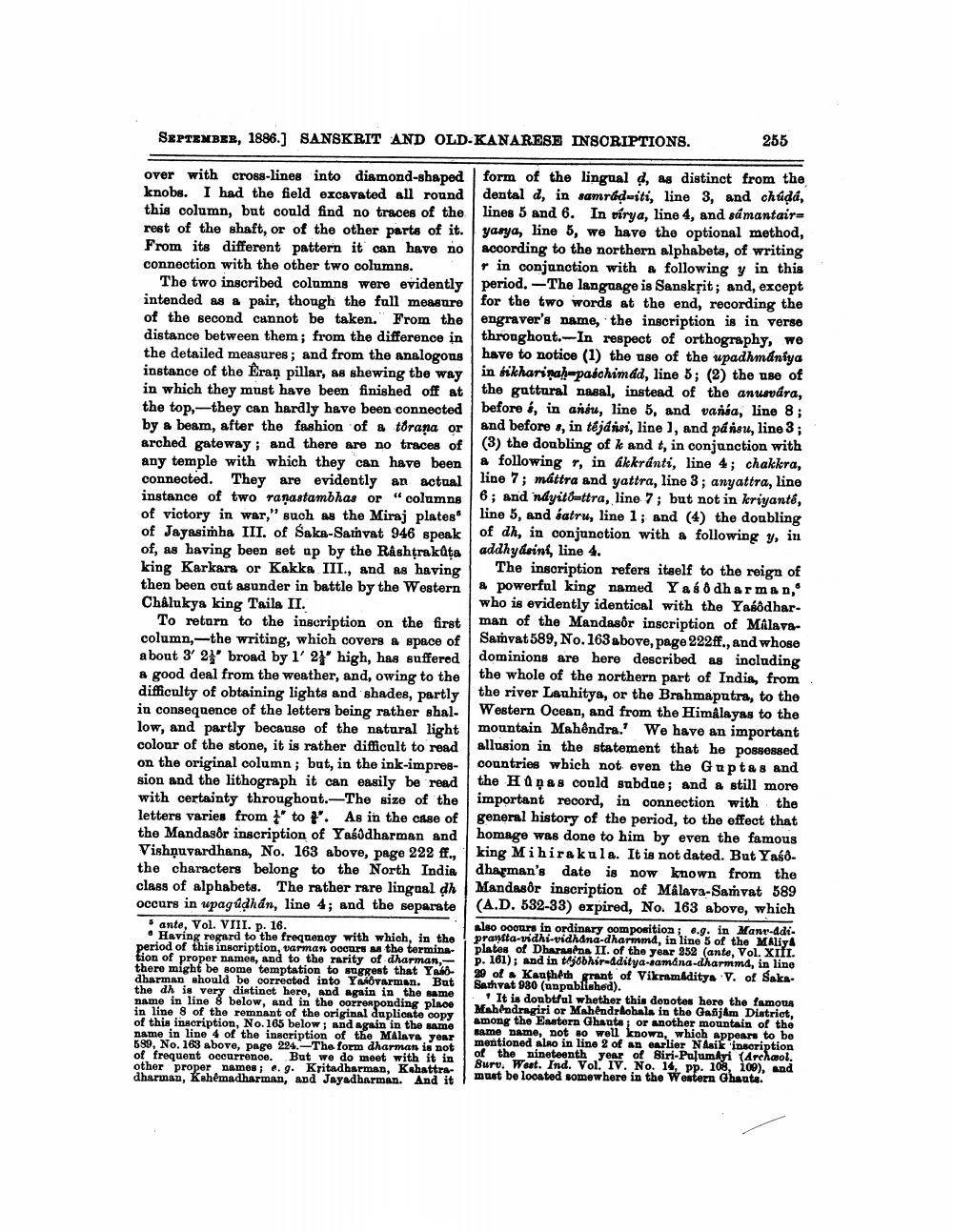________________
SEPTEMBER, 1886.] SANSKRIT AND OLD-KANARESE INSCRIPTIONS.
255
over with cross-lines into diamond-shaped form of the lingual d, as distinct from the knobs. I had the field excavated all round dental d, in samrádeiti, line 3, and chudá, this column, but conld find no traces of the lines 5 and 6. In vírya, line 4, and sámantairrest of the shaft, or of the other parts of it. yasya, line 5, we have the optional method, From its different pattern it can have no according to the northern alphabets, of writing connection with the other two columns. r in conjunction with a following y in this
The two inscribed columns were evidently period. -The language is Sanskřit; and, except intended as a pair, though the full measure for the two words at the end, recording the of the second cannot be taken." From the engraver's name, the inscription is in verse distance between them; from the difference in throughout.-In respect of orthography, we the detailed measures; and from the Analogons have to notice (1) the use of the upadhmdniya instance of the Praņ pillar, as shewing the way in tikharinah-paschimdd, line 5; (2) the use of in which they must have been finished off at the guttural nasal, instead of the anusvára, the top, they can hardly have been connected before é, in ansu, line 5, and vanía, line 8; by a beam, after the fashion of a törana or and before, in tējáisi, line ], and pa nisu, line 3; arched gateway; and there are no traces of (3) the doubling of k and t, in conjunction with any temple with which they can have been a following r, in akkránti, line 4; chaklera, connected. They are evidently an actual line 7; máttra and yattra, line 3; anyattra, lino instance of two ranastambhas or “columns 6; and ndyitottra, line 7; but not in keriyanté, of victory in war." such as the Mirai plates line 5, and áatru, line 1; and (4) the doubling of Jayasimha III. of Saka-Samvat 946 speak of dh, in conjunction with a following y, in of, as having been set up by the Rashtrakata addhyasini, line 4. king Karkara or Kakka III., and as having The inscription refers itself to the reign of then been cut asunder in battle by the Western a powerful king named Yaś 8 dharman, Chalukya king Taila II.
who is evidently identical with the YaśðdharTo return to the inscription on the first man of the Mandasör inscription of Malavacolumn, -the writing, which covers a space of Samvat 589, No. 163 above, page 222ff., and whose about 3' 21' broad by 1' 2y high, has suffered dominions are here described as including a good deal from the weather, and, owing to the
the whole of the northern part of India, from difficulty of obtaining lights and shades, partly the river Lanhitya, or the Brahmaputra, to the in consequence of the letters being rather shal. Western Ocean, and from the Himalayas to the low, and partly because of the natural light mountain Mahêndra.' We have an important colour of the stone, it is rather difficult to read allusion in the statement that he possessed on the original column; but, in the ink-impres- countries which not even the Guptas and sion and the lithograph it can easily be read the Haņas conld subdue; and a still more with certainty throughout.-The size of the important record, in connection with the letters varies from * to '. As in the case of general history of the period, to the effect that the Mandasôr inscription of Yasodharman and homage was done to him by even the famous Vishnuvardhana, No. 163 above, page 222 ff., 1 king Mihirakula. It is not dated. But Yaś8the characters belong to the North India dhapman's date is now known from the class of alphabets. The rather rare lingual dh Mandasör inscription of Malaya-Samvat 589 occurs in upagúðhán, line 4; and the separate (A.D. 532-33) expired, No. 163 above, which ante, Vol. VIII. p. 16.
also ooours in ordinary composition 6.9. in Mane-ddi. • Having regard to the frequency with which, in the pranta-vidhi-vidhana-dharmmd, in line 5 of the Maliy period of this inscription, varman oocars as the termine plates of Dharuaena II. of the year 352 (ante, Vol. XII. tion of proper names, and to the rarity of dharman, p. 161); and in tjobhir-dditya lamang-dharmmd, in lino there might be some temptation to suggest that Yab. 29 of Kaufheth grant of Vikramaditya V. of Sakadharman should be corrected into Y RÖVarman. But
Sathvat 980 (unpublished). the dh is very distinct here, and again in the same
| name in line 8 below, and in the corresponding place
It is doubtful whether this denotes here the famous in line 8 of the remnant of the original daplionto copy
Mahindragiri or Mahendrlobala in the Gafijam District, of this inscription, No. 165 below and again in the same
among the Eastern Ghanta or another mountain of the name in line 4 of the inscription of the MAlava year
same name, not so well known, which appears to be 599, No. 163 above, page 224.-The form dharman is not
mentioned also in line 2 of an earlier N Asik inscription of frequent occurrence. But we do meet with it in
of the nineteenth year of Siri-Palumkyi (Archaol. other proper dames; e. 9. Kritadharman, Kahattra 1
Suru. West. Ind. Vol. IV. No. 14, pp. 108, 109), and dharman, Kshemadharman, and Jayadharman. And it must be loosted somewhere in the Western Ghana




